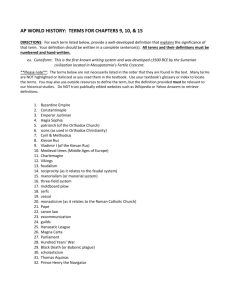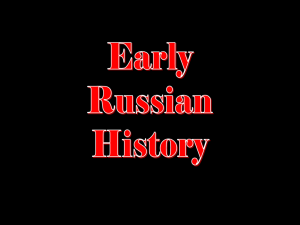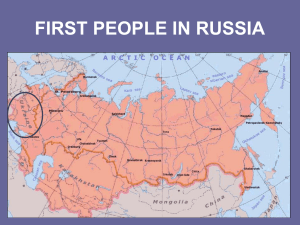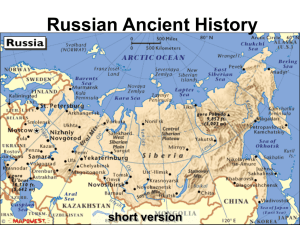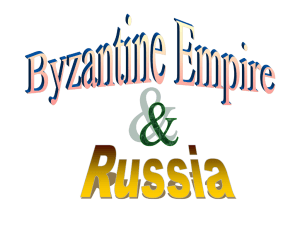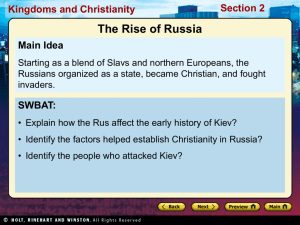PPt 4 of 4 - Christianity Spreads to Eastern Europe
advertisement
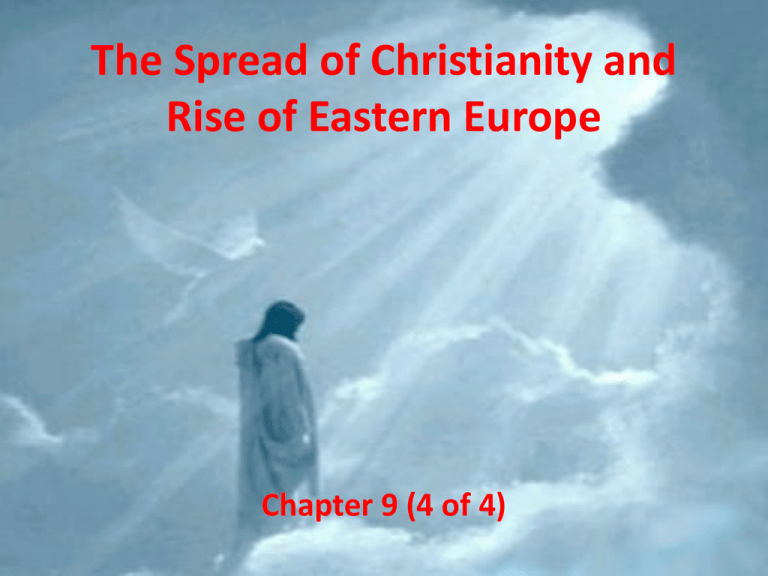
The Spread of Christianity and Rise of Eastern Europe Chapter 9 (4 of 4) Through Missionaries, the Byzantines Spread Christianity to the Balkans and Russia (Eastern Europe) Cyril and Methodius Missionaries sent by Byzantines to convert people of eastern Europe So, as Christianity spread, so did literacy and literature Created a written language for the Slavs derived from Greek (called Cyrillic) Byzantine missionaries allowed local languages to be used in church (unlike Catholics) Competing Catholic missionaries already sent to convert eastern Europe Below are 3 major areas Catholics converted in the western half of eastern Europe Catholic successful at converting the western half of eastern Europe Poland Bohemia (now Czech Republic) Hungary Jews Settle in Eastern Europe as Minority Group Many settle in eastern Europe (especially Poland) though still discriminated (ex: barred from agriculture) Jews being discriminated against harshly in western Europe and Middle East Jews stressed education to their boys (as other societies weren’t) which would prove valuable Russia is Born! The Russian People Slavs from eastern Europe move into area that is now Russia and mix with the people already there to start the foundation of Russian society Religiously, the Slavs were animists and had different gods for sun, thunder, wind, and fire Russia Starts in Kiev Byzantines traded a lot with Scandinavia and traveled through what is now Russia to trade Kiev = trade city in south Russian (formed by Scandinavians/ Vikings) that grew b/c it was along trade route Kievan Rus’ • Formed in 855 by the Prince Rurik • Kingdom based out of Kiev • Kievan Rus’ formed the basis for later Russia Kievan Rus’ • Kievan Rus’ trade with Byzantine continues to increase • Many Russians visited Constantinople • As a result, many Slavs (the ethnic group of Kiev) learned about Christianity Ruled Kiev from 980 1015 Converted Kiev to Christianity Forced people to convert that were unwilling Vladimir I didn’t like Catholicism (Pope too much influence) Vladimir I didn’t like Islam (not allowed alcohol) Rurik Many fell in love with splendor of Orthodox Church Byzantine Church leaders brought into Kiev to train Russian priests Like in Byzantine Empire, king was in control of church Russian Orthodox – New form of Christianity (similar to Orthodox religion of Byzantines Kievan Rus’ had formal code of law like the Byzantines Kievan Rus’ started by Rurik, but expands greatly under his successors Kievan Rus’ originally just city of Kiev, but when Kiev expanded becomes Kievan Rus’ Yaroslav the Wise • Last great Kievan prince • Made legal code • Built many Churches • Had religious text translated from Greek to Slavic Culture in Kievan Rus’ Similar to Byzantine culture • • • • • Large religious ceremonies Idea that ruler had great power Churches fancily decorated (ornate) Used icons and incense Polygamy replaced by monogamy Russian (Kievan) Literature Used Cyrillic alphabet, and often wrote about religious and royal events Through literature we know they saw disasters as punishment from God, and success as a reward The Boyars Boyars = Russian aristocrats Less political power than aristocrats in western Europe The End of Kiev Kiev declines in the 1100s for several reasons • • • • Royal families fight over succession Asian invaders begin taking territory Lost trade with Byzantines b/c that empire fading Rival princes broke away and formed own kingdoms TATAR KIEV! Tatar = Russian term for Mongol invaders Under Mongol (Tatar) rule, Russia further separated from western Europe Mongols invaded and capture Russia (Kievan Rus’) by 1241 Tatars allowed Christianity to survive, This ended the first chapter in Russian history as Mongols ruled for next 200 years When Tatars lost Russia in 1400s, enough Russian culture survived and Russia reemerged From Rome to Byzantium to Russia As the Byzantine Empire fell in 1453, Russia was reemerging from Mongol rule, and took the mantle from the Byzantines as the leaders of eastern Europe, but by then western Europe had surpassed the east
